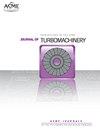探索声流控制在翼型上的物理特性,以实现对高功和升程涡轮的潜在应用
IF 3.1
3区 工程技术
Q3 ENGINEERING, MECHANICAL
引用次数: 0
摘要
在本研究中,声学驱动实验应用于模拟高功升低雷诺数翼型压力分布的简化驼峰几何上的大规模分离流动。声激励对流动分离具有显著的控制作用,与具有相似动量系数的标准局部驱动技术相比,其相对升力增强更高。为了解释分离控制的物理机制,采用全场速度测量来检验驱动流的瞬态行为。速度测量结果显示,在分离点的上游存在一个粘性壁面模式,该模式组织了涡度。时空关联分析发现,这些附著流壁面模式的产生是分离剪切层后续重组和分离动力学变化的主要原因。壁面模态对声流控制机制的重要性对高速涡轮机械声控制策略的设计具有重要意义。沿着这些路线,这种现象的分支探索几何设计近似流场在高速涡轮机械。在有利的斯特劳哈尔数(与雷诺数的平方根成线性比例)下,在发动机典型环境的激励振幅范围为~ 128dB时,可观察到高达22%的升力增强。在许多不同的流动控制技术中,声学可以有效地应用于低雷诺数涡轮叶片,随着对高流动转向的需求不断增加,低雷诺数涡轮叶片在非设计条件下容易发生流动分离。本文章由计算机程序翻译,如有差异,请以英文原文为准。
EXPLORING PHYSICS OF ACOUSTIC FLOW CONTROL OVER AIRFOILS TOWARDS POTENTIAL APPLICATION TO HIGH WORK AND LIFT TURBINES
Abstract In this study, acoustic actuation was applied experimentally to massively separated flows on simplified hump geometries which mimic the pressure distribution over high-work-and-lift low Reynolds airfoils. The acoustic excitation demonstrated significant control over flow separation, resulting in higher relative lift enhancement than standard, localized actuation techniques with similar momentum coefficients. Full field velocity measurements were used to examine the transient behavior of the actuated flow in order to explain the physical mechanism of separation control. The velocity measurements revealed the presence of a viscous wall-mode that organized the vorticity upstream of the separation point. A spatiotemporal correlation analysis found that the generation of these wall modes in the attached flow was the dominant cause of the subsequent reorganization of the separating shear layer and the change in separation dynamics. The importance of wall-modes to acoustic flow control mechanism has important implications for the design of new acoustic control strategies for high-speed turbomachinery. Along these lines, the ramifications of this phenomena are explored over geometries which are designed to approximate flow fields in highspeed turbomachinery. At the conducive Strouhal number, which scale linearly with the square root of Reynolds numbers, up to 22% lift enhancement is observed for excitation amplitudes in the range of ∼128dB, typical to the engine environment. Of many diverse flow-control techniques, acoustics can be effectively employed in low Reynolds turbine blades, which are prone to flow separation in the offdesign conditions with the ever-increasing demand for higher flow turning.
求助全文
通过发布文献求助,成功后即可免费获取论文全文。
去求助
来源期刊
CiteScore
4.70
自引率
11.80%
发文量
168
审稿时长
9 months
期刊介绍:
The Journal of Turbomachinery publishes archival-quality, peer-reviewed technical papers that advance the state-of-the-art of turbomachinery technology related to gas turbine engines. The broad scope of the subject matter includes the fluid dynamics, heat transfer, and aeromechanics technology associated with the design, analysis, modeling, testing, and performance of turbomachinery. Emphasis is placed on gas-path technologies associated with axial compressors, centrifugal compressors, and turbines.
Topics: Aerodynamic design, analysis, and test of compressor and turbine blading; Compressor stall, surge, and operability issues; Heat transfer phenomena and film cooling design, analysis, and testing in turbines; Aeromechanical instabilities; Computational fluid dynamics (CFD) applied to turbomachinery, boundary layer development, measurement techniques, and cavity and leaking flows.

 求助内容:
求助内容: 应助结果提醒方式:
应助结果提醒方式:


